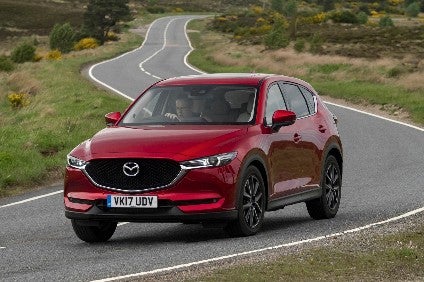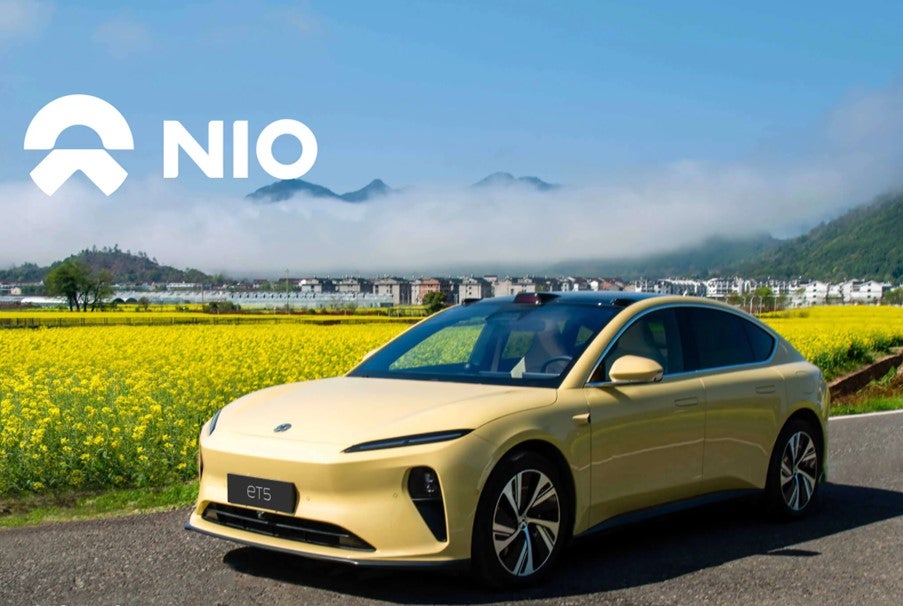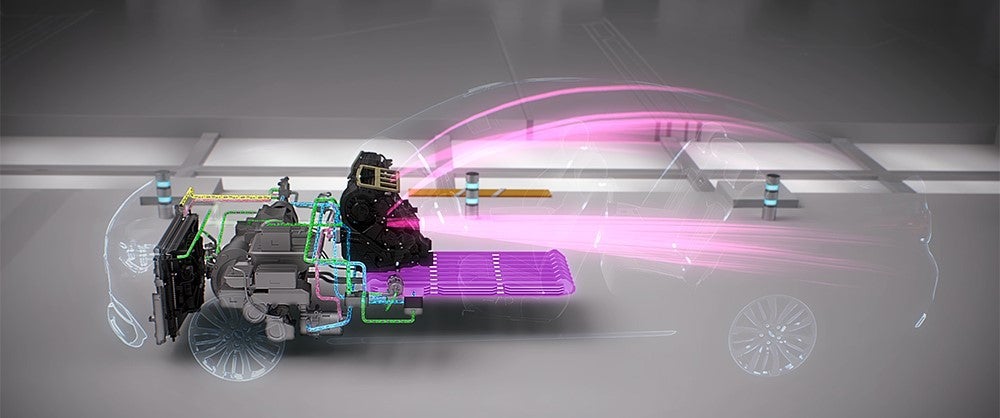
At first glance, the casual observer might dismiss the ‘all new’ claims of its maker Mazda for the second generation CX-5 crossover. Sure, it looks very familiar but closer scrutiny soon notes the chunkier nose with more chrome, a sleeker stance, completely reshaped panels, much classier interior and new features such as a much better heads-up display and a power tailgate. Good bits like the Skyactiv petrol and diesel engines, six-speed manual and automatic transmissions carry over, with improvements. It’s a class act, and just great to drive.
The outgoing CX-5 bore on its shoulders the 2012 introduction of ‘Skyactiv’ engine, powertrain and body design technology and the so-called Kodo: Soul of Motion design philosophy, rewarding Mazda with global sales of over 1.5m – or roughly 25% of its volume – with around 32,000 sold here in the UK.
I’d argue the greatest improvement is to the interior, now much classier in materials quality and finish which, along with attendant detail to NVH reduction and careful seat design and shaping – rear seat backrests also now recline a shade and there are now a/c vents for back seat riders – makes the car ideal for long-distance travel. In non-stop heavy rain, and on challenging Scottish roads, we spent almost seven hours in two examples and stepped out relaxed, without aches or pains, looking forward to another two hours of travel in a third variant next morning. Mazda has boosted torsional body rigidity 15% over the outgoing model, and made refinements to the steering, suspension and brakes, plus introduced G-vectoring control (GVC) and that must explain the crisp road holding, lack of excessive body roll and the overall impression of comfort and refinement.
Range
Unlike the European contenders, with the VW Tiguan springing to mind (Mazda also cites the Nissan Qashqai, Ford Kuga and Toyota RAV4 as rivals), the Japanese brands tend to keep things simple so, instead of multiple drivetrains, several trim levels and a humongous options list, Mazda blends one petrol and two diesel engines, manual or automatic transmission and nicely-equipped SEL-Nav and loaded Sport Nav trims into just 10 variants priced from GBP23,695 to GBP33,195. Options are limited to three grades of metallic paint, a GBP200 grey ‘stone’ leather trim (in lieu of black hide) for Sport Nav models only, a GBP800 safety pack restricted to Sport Nav diesels and GBP800 radar cruise control restricted to 175PS diesel auto Sport Nav models with the safety pack box already ticked.
It’s really a case of perusing the price list and picking the model with the feature set closest to what you want – you can’t have the 165ps two-litre petrol engine with automatic transmission and/or 4WD (boo) but you can have the 150PS 2.2 diesel with 2WD, 4WD, manual and auto and SE-L Nav trim but not with 4WD if you want Sport Nav luxury. Choose the 175PS diesel and it comes only with 4WD and Sport Nav trim, you decide between manual and auto.
How well do you really know your competitors?
Access the most comprehensive Company Profiles on the market, powered by GlobalData. Save hours of research. Gain competitive edge.

Thank you!
Your download email will arrive shortly
Not ready to buy yet? Download a free sample
We are confident about the unique quality of our Company Profiles. However, we want you to make the most beneficial decision for your business, so we offer a free sample that you can download by submitting the below form
By GlobalDataBoth Skyactiv-D diesel engines now have Mazda’s noise reducing ‘natural sound smoother’ technology which entails the fitting of a dynamic damper within the pin securing the piston to the connecting rod to reduce start-up and idle reverberation. Transient control sharpens throttle responsiveness by more precise control of engine torque with optimised turbo pressure and finer adjustment of fuel injection.
All models have LED headlights, auto power-folding door mirrors, dual-zone climate control, DAB (digital) radio, a seven inch, colour touch-screen display with integrated navigation with map updates for three years, adaptive front lighting and dusk sensitive headlights, rain sensing wipers, cruise control, electronic park brake, Bluetooth, Smart city brake support, stability and traction control and hill holder.
Sport Nav cars add a reversing camera, eight-way power adjustable driver’s seat and smart keyless entry, six-way power front passenger seat, heated front seats and steering wheel, black leather trim, a redesigned HUD (with traffic sign recognition) now projected on to the windscreen (instead of a pop-up screen), Bose sound and a power liftgate. The electric driver’s seat has a two preset memory function which also allows for the automatic height adjustment of the head-up display when switching drivers. The presets can also be matched to the smart keyless entry key fob.
One little quality improvement: the interior of the glovebox is now flock-lined, something Japanese automakers have taken years to learn to do – it stops objects rattling in there.
Changes
The latest CX-5 is just 10mm longer and 35mm lower than its predecessor but retains the same 2,700mm wheelbase. With both the front and rear tracks slightly wider than before and the wheels placed as close as possible to the outer edges of the body shell, it manages to look a lot sleeker. The drag coefficient has been lowered by about 6% and boot volume has increased from 503 to 506 litres while the use of a 9mm thinner boot floor board has increased under-floor storage volume. The overall body structure has been revised with the A pillars repositioned some 35 mm further back and the relative positions of the front axle and A pillars optimised.
Mazda highlights new Soul Red Crystal paint, a GBP800 option, which uses three coats – a reflective layer, a translucent layer and a clear top coat. To achieve a purer red, the translucent layer adopts a high chroma pigment with an optimised particle size, creating a deeper hue and more vivid colouring. The reflective layer is thinner, and uses smaller, high-brightness aluminium flakes. It also contains light absorbing flakes that intensify shaded areas, achieving a visual depth that previously required a second coat. The end result is precisely controlled reflections which produce more vivid highlights and even deeper shadows.
The body uses 3% more ultra high tensile steel and is 15% more rigid. While the basic structure of the platform is carried over, about half the parts have been changed or redesigned.
G-Vectoring Control (GVC)
The first of Mazda’s new Skyactiv-Vehicle Dynamics range of technologies – G-Vectoring Control (GVC) already seen on some other models – uses integrated control of the engine, transmission and chassis to enhance the connection between car and driver and varies engine torque to optimise vehicle dynamics. By monitoring steering and throttle position when entering a corner under power, GVC momentarily reduces the amount of torque delivered to the front wheels, thereby transferring a fraction more weight onto the front axle. This increases front tyre grip, which allows the front wheels to turn more precisely.
Standard with the 150ps and 175ps diesels, the latest intelligent AWD system uses 27 sensor signals to monitor road conditions and driver intentions, determining how power should be split between the front and rear wheels. The active torque control coupling sends the right amount of torque to the right place at the right time, maximising front and rear grip by precisely calculating how much is required at each wheel, when road conditions are constantly changing. This also delivers fuel efficiency by ensuring torque is not transmitted to the rear wheels when conditions don’t demand it. With the focus on fuel efficiency, under most normal driving conditions torque split to the rear wheels can vary from as little as 1% to 50%.
Inside
Across all models the legibility of instrument displays has been optimised for quicker and easier reading. The new seven inch centre display is the first in a Mazda to adopt optical bonding to join the liquid crystal display and touch panel which suppresses reflections and presents a clearer image. The multi-information display mounted within the right-hand dial of the driver’s instrument binnacle features a new, 4.6-inch colour TFT LCD screen, with related information grouped.
MZD-Connect includes Bluetooth, email, SMS and navigation plus mobile infotainment services from Aha, including internet radio stations, Twitter and Facebook feeds, news and audio books.
Air conditioning vents for back seat passengers have been added to the rear of the central console while thinner glass and a smaller power mechanism give the 175PS Sport Nav’s standard slide and tilt sunroof a 45 mm bigger opening – the lack of a huge panoramic roof and electric sun screen seems a little old-fashioned.
Mechanical
Mazda said the Skyactiv-Drive six-speed lock-up automatic transmission for the 150PS and 175PS turbodiesels is the first to adopt a low-rigidity lockup damper which is equipped with damper springs that feature a larger stroke and wider torsion angle. While improving driveshaft rigidity to support the engine’s maximum torque of 420Nm, the new springs also optimise torsional rigidity by extending the stroke of the lockup damper. As a result, the transmission delivers a quieter drive with a wider lockup range, and further increases fuel efficiency in the practical operating range.
The new generation, intelligent all wheel drive is said to have been significantly improved by the adoption of ball bearings for all its power take off and rear differential unit bearings and this is the first Mazda car to also feature tandem ball bearings in locations where a high level of rigidity is required under heavy load. The load bearing rotation of the balls within the bearings has resulted in a dramatic reduction in resistance of some 30% compared to the previous system, with a resulting 2% improvement in real world fuel economy.
Refinement
Refinement enhancements and the reduction of road noise were key targets of development. To that end, a particular focus has been paid to the reduction of low frequency road noise, and high frequency wind and tyre noise when driving at speed.
Vibrations from the tyres, suspension and body were suppressed to reduce unpleasant road noise stemming from rough surfaces. To minimise the transmission of vibration through the suspension, measures implement to finely control resonance and reduce input force include the adoption of hollow stabilisers and dynamic dampers to the front struts. Efforts to minimise energy from vibrating body panels radiating into the cabin focused primarily on using CAE analysis to optimise the shape of beading and other parts to reduce vibration.
Measures have been taken to block the paths by which high frequency tyre noise might intrude into the cabin. Sealant has been applied to close the gaps between the body panels below the B pillars. For the lower part of the body panels below the side sills, where the application of sealant is difficult, gaps have been minimised to prevent noise intrusion. Further measures extend to the interior, including the minimisation of the gap between the loadspace compartment side trim and floorboard.
Measures to reduce wind noise began with the aerodynamic styling of the body itself, which is designed to suppress air turbulence. The windscreen wiper stowage position is located below the surface extension of the bonnet (the wipers disappear from view in the cabin) and both door mirrors and A pillars are aerodynamically shaped to reduce wind noise. Door and garnish gaps have also been minimised, and both the doors and tailgate benefit from parting sealant.
Safety
Standard across the range, advanced smart city brake support (advanced SCBS) uses a forward sensing camera, which has an expanded detection distance and widened view angle. The forward detection speed range has grown from 2-19mph to 2-50mph. The system can also detect pedestrians within a speed range of 6-50mph.
The system automatically stops or reduces the speed of the car when there is a risk of collision with the vehicle or pedestrian in front. If there is the danger of a collision, the system alerts the driver using a warning sound and graphic indication, and if it detects a collision is imminent and unavoidable, the system automatically applies the brakes. In addition, via the use of ultrasonic sensors, rear smart city brake support works in reverse at speeds of 1-5mph and is part of the GBP800 safety pack offered on Sport Nav diesel models.
The pack also offers adaptive LED headlights. The number of blocks into which the LED array is split has been increased from four to 12, and a monocular unit has been adopted for both high and low beam lamps. With each block able to be independently lit or extinguished, the 12-split LED array offers finer control of illumination and an increased upper light intensity during high beam cruising to give more timely awareness of pedestrians.
By using the forward sensing camera, the enhanced system can deliver glare free high beam, wide range low beam and highway mode. When travelling at speeds of 25mph and above, glare free high beam detects the position of the vehicle ahead or an oncoming car and turns off sections of the LEDs so that the high beams can be used continuously without dazzling other vehicles.
At speeds of up to 25mph, wide-range low beam ensures the LED lights illuminate both sides of the road over a wider spread – including the area visible between the A pillars and door mirrors – to help light up junctions and turns. Operating at speeds over 60mph, highway mode increases visibility at a distance by raising the headlamp optical axis when driving at motorway speeds.
Other key i-Activsense driver supporting technologies included in the optional safety pack include lane keep assist with driver attention alert, blind spot monitoring with rear cross traffic alert and the rear smart city brake support.
At speeds above 38mph, lane keep assist uses the forward sensing camera to monitor the road markings, supporting the driver in steering the car by providing steering torque assistance. It works very well and unobtrusively; I am prone to ‘lane wander’ and appreciate a bit of help from the in-car nanny. The supporting lane departure warning system predicts lane departures and vibrates the steering wheel or sounds an alert to support the driver’s awareness of dangers.
Blind spot monitoring with rear cross traffic alert uses a millimetre wave radar sensor to monitor the blind spot areas to the sides and rear. The system becomes operational at speeds over 19mph and if the driver switches on a turn signal whilst the system detects vehicles approaching from behind, it warns them with a flashing indicator in the respective door mirror and sounds an alert. The system also uses the same sensor for its rear cross traffic alert function.
Operational above 40mph, driver attention alert monitors the steering wheel angle and vehicle speed, combining this with information from the forward sensing camera to monitor the driver’s condition. Should it recognise any noteworthy changes in driver behaviour, the system will recommend a break every two hours through the use of both visual and audible alerts.
Available as a GBP800 option on 175ps Sport Nav Auto models in conjunction with the safety pack, Mazda radar cruise control (MRCC) with stop and go function is now available on the CX-5. MRCC is newly equipped with an auto-hold function which holds the vehicle in place even after the driver lifts a foot off the brake pedal, releasing the brakes only once the driver presses the accelerator pedal.
The updated system for the CX-5 combines the radar of the previous system with the new forward sensing camera. This expands its minimum operating speed from 19mph down to 0mph, and enables the driver to activate the system at any speed ranging from stationary up to 124mph.
UK
The new model goes on sale on 30 June and Mazda UK, with 34,664 previous model sales under its belt, expects mix to be roughly the same – 54% retail sales, 84% diesel, 67% 2WD, 78% manual, 59% Sport Nav, 56% 2.2 diesel. Sales target is 8,000 a year.
CX-5 accounts for 28% of Mazda’s European sales and 20% in UK.





